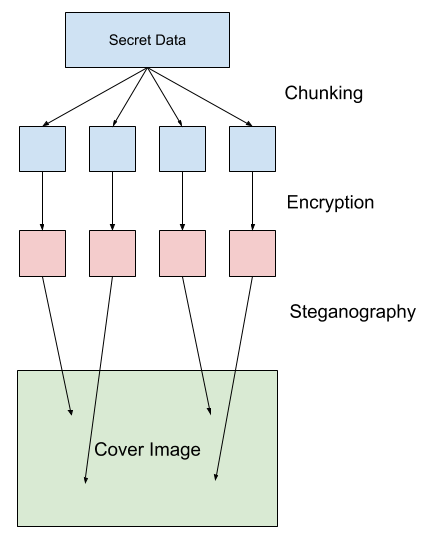Parallel Steganographic Encryption

Summary
Steganography and encryption are two methods of securing digital data. Steganography involves hiding data in other data while encryption involves making data unreadable. None of these methods result in 100% security and there exists techniques and ways to recover secret data that is either hidden by steganography or jumbled up by encryption. Time is the limiting factor when in comes to security and data is, generally, considered more secure if the time it takes to brute force the data is extremely long. More secure encryptions are possible but sometimes they are not worth the time and resources it takes to encode and decode the secret data.
Contributions
In this project with Ryan Tanaka we propose a fast method to both hide and secure secret data. We explore combining steganography with encryption to add another level of security to our data. Individuals attempting to recover our secret data would have to first recognize that data is present. If they were able to discern if secret data is present, it will still be in an unreadable form and they would be required to break the encryption. We take secret text data, encrypt it, then hide it within different parts of an image. This process can be lengthy however, we leverage multi-threading to help us parallelize this process. Most encryption algorithms are heavily data dependent and are not able to be parallelized. The use of steganography grants us more security and presents an avenue for us to exploit parallelization and runtime speedups.
We implemented our algorithm in C++ with the help of OpenCV. Experiments on an 8 and 16 core machine to evaluate speed up and how different number of threads affect performance. Parallel programming also presents with many unique bugs that aren’t present in sequential code. We tested the correctness by encoding a message with our protocol and seeing if we could recover that same message by our decoding protocol. To evaluate whether our steganographic hiding of our message in an image was effective we performed a mean squared error and least significant bit analysis.
Learned
Prior to this project my experience in security was minimal. With this project I was able to learn more about cryptography and encryption. I learned about different encryption algorithms when we were trying to determine what to use; these included AES, DES, and RSA. I also improved upon my parallel programming skills when dealing with the parallel steganographic encoding. I gained some experience with image processing with OpenCV. Testing, debugging, and running experiments are also skills that were practiced and improved upon during this project.
- Paper to be submitted. Code, algorithm, and results available upon email
- request.
